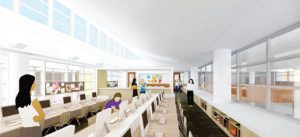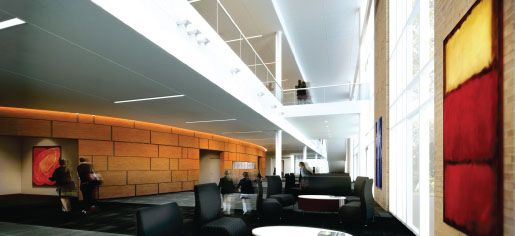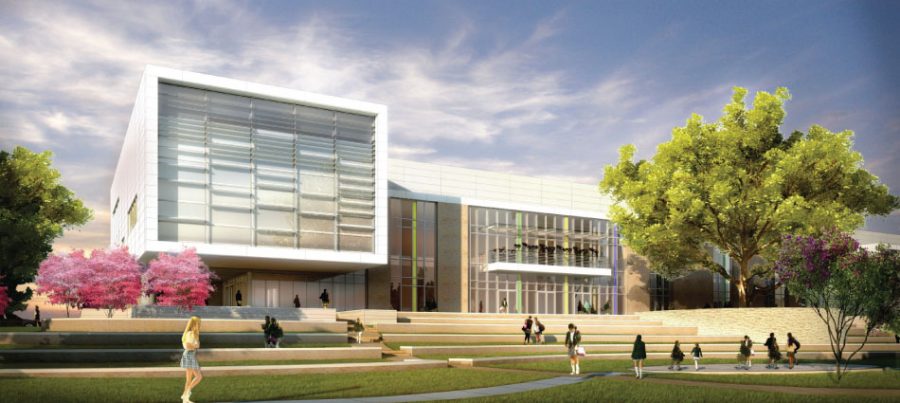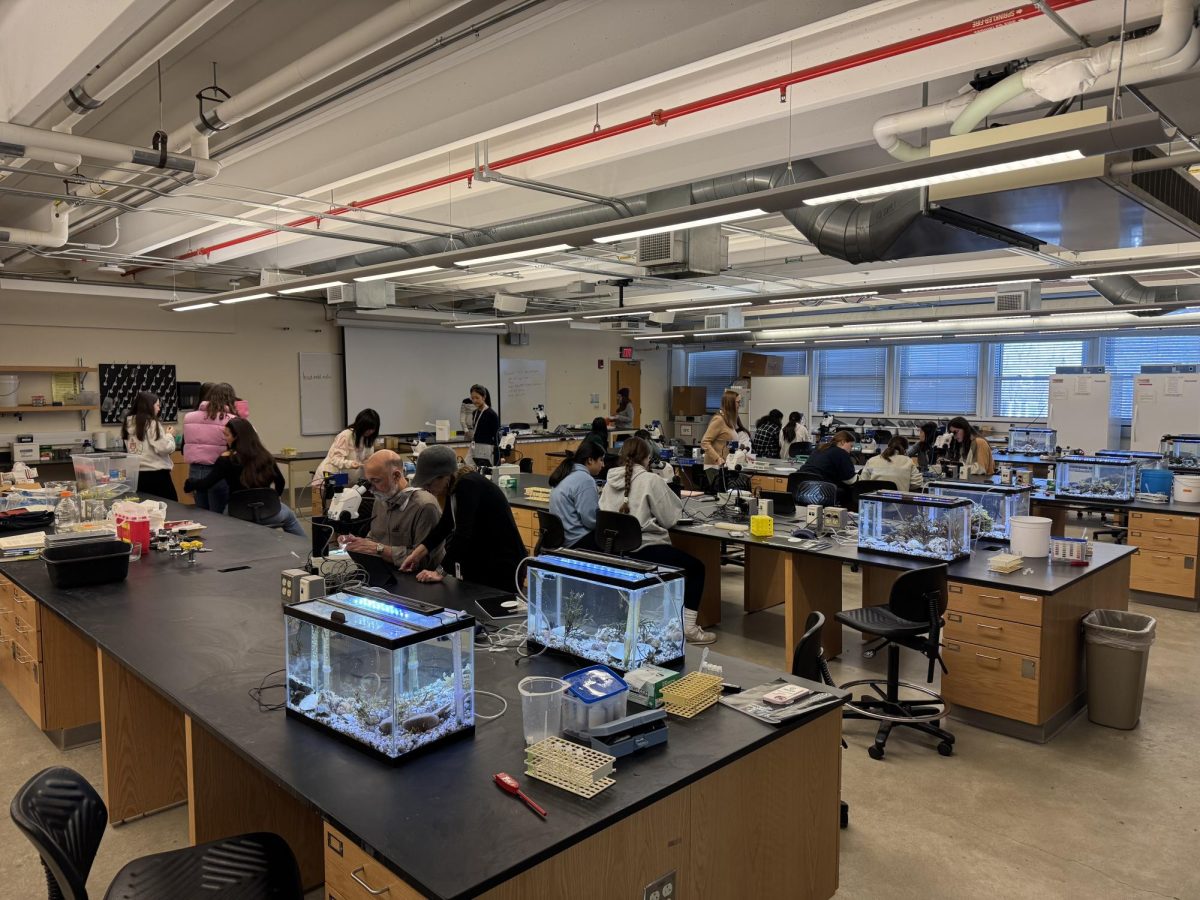

Junior Charlotte remembers Pre-K in the rotunda of 12 years ago, a building which was demolished the following summer to make way for the new Liza Lee Academic Research Center, more commonly known as the ARC.
A few years later, as Gunn prepared to make the transition into Middle School, all of the classroom buildings were renovated into the ones we currently use today. As she enters this fall for her senior year, she will see more changes to the ARC.
And she will graduate shortly before gaining access to the new science and fine arts buildings, which will be renovated starting in spring of 2013 in a fresh round of construction. After the buildings are complete, the school will be practically unrecognizable from when Charlotte started at Hockaday in 1999.
“It has been strange to see buildings where I first played in, grew up in and learned so much in be torn away and rebuilt,” Gunn said. “All the change has been for the better I’d say though. Even though the carpets and chairs and teachers aren’t identical to those I knew, I can’t help but be excited for the current daisies!”
This summer, the debate and photography departments will move into the ARC. Renovations will begin at the end of the school year, and the Upper School library will close on May 14 in order to begin preparations.
A photography lab will replace the current publications room on the third floor of the ARC and will be complete with a working computer lab, lighting studio and small wet lab for old-fashioned photo developing.
Furthermore, one of the second floor computer labs will be renovated into “a more functional broadcast studio,” complete with green walls and an editing booth, Associate Head and Chief Financial Officer Mary Pat Higgins said. The other computer lab will be transformed into a film studies room, with new Apple computers equipped with film editing software. Film Study classes will be added into Middle and Upper School courses starting next year.
In addition, debate will move out of the fine arts building and into the ARC’s second floor library on the side closest to the science building. The new debate suite will include large tables, two offices for the teachers and several practice rooms.

Director of Debate Eric Melin looks forward to “more space, because right now we’re cramped” in the current building. The new room will have outlets in the floor and a place for every student to sit so girls are not forced to sit on the floor.
Melin hopes their move “will create more traffic to one of the coolest buildings on campus,” since most students “don’t spend as much time in the ARC.” This new room will allow the students to “break apart and have multiple practice rounds, so the students can practice a lot more during class,” Melin said.
The last renovation to be completed this summer will be on the publications facilities. The publications classroom will move to the third floor library directly over the new debate suite. At almost 2400 square feet, this room will be significantly larger than the current room and will include 28 movable computer stations in addition to offices for students and publications teachers.
In the middle of the room, a large work station will provide space to plan layouts. The other side will feature a long table with a SMART board at either end.
“I’m really excited for our huge conference table because I think it will unify the staff and help us put out a better product,” junior and co-editor of the 2013 Cornerstones Laura said.
But even larger renovations will begin—at earliest—on the tentative date of June 2013, taking 15 months and ending tentatively in August 2014. As part of the Centennial Celebration, the Board of Trustees has planned to renovate the fine arts and science buildings. And with Lyda Hill’s $20 million gift ($10 million for endowment and $10 million for science building renovations), the renovation started to become a reality.
The Centennial Capital Campaign will raise money to “support the different components of the school’s strategic goals to thrive in the next 100 years,” Higgins said. The timing of this project is still undecided because the fundraising phase has just begun.
Both the fine arts and science buildings will be expanded and ultimately become one building called the Centennial Center, allowing the two disciplines to “really be integrated and open on every floor,” Higgins said.
One-hundred seats will be added to Hoblitzelle Auditorium to seat 650 people. It will be surrounded by space for the scene and set shop, costume storage, a wardrobe closet and a dressing room with 30 mirror stations.
In addition, a new dance studio will open up directly to backstage, so girls will not clutter the hallways during performances. Each hallway will be 10 feet wide.
The auditorium will also include a full fly space, a tower that can hold a full backdrop above the stage.
“This will give us a lot more options for how we do sets and backgrounds for our productions,” said Higgins.
Another perk for the drama department, the hill that leads up to Hoblitzelle is “the perfect space to create a terraced garden” for outdoor plays or a place to relax outside, Higgins said.
“The fine arts renovation will do great things for the students involved in fine arts and give the fine arts teachers the ability to do amazing things,” junior Ashley said. “I only wish that I would get to be here to make use of it.”
Although ceramics will stay put after the renovations, the studio art room will gain an outdoor balcony on which students can work. The orchestra building, choir room and Blackbox Theater will relocate to the third floor of the building.
Science Department Chair Dr. Beverly Lawson has looked forward to a third floor on the science building since she began working at Hockaday 26 years ago.
“We’re excited about a lot of things, like having more space,” she said. “We’re bursting at the seams right now.”
In the science realm, Clements Lecture Hall will be renovated and the science building will be organized so that classrooms for each discipline (three each for physics, biology and chemistry) are together so that teachers “can work together easier,” Higgins said.
On the third floor, the Junior Engineering Technical Society Club will gain more space to work on their robotics and other engineering projects. Also, an outdoor green-lab rooftop garden will be constructed on top of the science building.
Furthermore, Hockaday’s History of Art and Music class will move into the science building’s new Digital Technology Seminar Room, with projection capabilities and possibly film screenings.
The new science building will also feature three IDEA Labs, a new type of classroom popular at the university level containing movable, flexible furniture. These spaces will never be used for classes but will serve as a space for students to meet and work on projects as needed. One on the labs will also include a planetarium.
“Since we are not able to fully anticipate what technology will be like in 20 years, these rooms will be flexible enough to be able to…accommodate a lot of activities,” Lawson said.
They will also allow students to establish and prolong research projects such as independent student research labs. Lawson said that she and the rest of the science faculty are “excited to help sponsor research developments.”
The connection between the fine arts and science buildings has instigated a new idea for more collaboration between the two subjects: STEAM, or the integration of science, technology, engineering, art and mathematics.
While STEM has existed at Hockaday for the past several years, arts will now be added to the mix. New classes will connect the fine arts with science such as explorations of color or the physics of dance.
“We’ve had a number of ideas for collaborating with fine arts before and have had a little bit of success, but the separation has made it hard. If we’re adjacent to one another, there will be more opportunities to do that,” Lawson said. “The really interesting questions are the ones that touch in many different fields at the same time.”
Fine Arts Department Chair Ed Long said that the need for collaboration between the arts and sciences stems from their mutual reliance on creativity, innovation and collaboration to produce modern consumer items like the iPhone.
“We have gotten to a place in society where you cannot produce a functioning object like an iPhone without it being beautiful,” he said. “The iPhone occurred with the designers and the scientists and the engineers collaborating together. The really profound objects of our time are all created by conjoining the arts and sciences.”
Even as the buildings become more technologically advanced, the caliber of teaching in Hockaday will remain the same.
“No matter how advanced the building and classrooms get, the same level of unique, personalized and empowering teaching will most definitely be present,” Gunn said. “I don’t expect anything less from the fabulous Hockaday faculty.”
Higgins too hopes that the renovations will keep Hockaday at the forefront of the movement to connect the arts and sciences.
“Everything you read about education talks about creativity and the design aspect which really blends science and arts,” she said. “It made sense to us to have the buildings merge.”
-Megan









